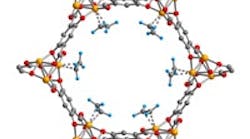Researchers at the University of California, Berkeley (UCB), Berkeley, Calif., have developed a hybrid metal-organic framework (MOF) that efficiently separates hydrocarbon gas mixtures that now are fractionated by energy-intensive cryogenic distillation.
The process could help chemical companies save energy costs and lower their environmental impact.
"You need a very pure feedstock of propylene and ethylene for making some of the most important polymers, such as polypropylene, for consumer products, but refineries dump a lot of energy into bringing the high temperature gases down to cryogenic temperatures," says Jeffrey Long, a professor of chemistry at the UCB and researcher at Lawrence Berkeley National Laboratory. "If you can do the separation at higher temperatures, you can save that energy. This material is really good at doing these particular separations."
Long and his team pumped a gas mixture through an iron-based MOF (Fe-MOF-74). Propylene and ethylene bind to the iron embedded in the matrix, letting pure propane and ethane through. Then, the MOF is heated or depressurized to release ethylene and propylene pure enough for making polymers. Lab trials produced 100% pure ethane, and propane close to 100% pure. The researchers believe the approach could yield comparable results on an industrial level. The team's findings were published in a recent issue of Science.
Tuning the adsorbent for a particular separation involves not only finding the right metal for the specific separation application, but also taking pore size, surface area, and the type of organic bridging ligand into account. As a result, the team used simulations to help predict adsorption selectivities and hydrocarbon separation capacity.
"We performed breakthrough experiments to directly measure the ethane/ethylene and propane/propylene separations capabilities of Fe2(dobdc). However, these experiments are both challenging and incredibly time consuming. In order to compare our material with others that have been reported we developed a method to simulate a material's separation capabilities from pure component adsorption isotherms. Since we found excellent agreement with our simulations and experimental results for Fe2(dobdc), we were able to predict selectivities and capacities for a number of other materials in order to compare them without ever having to do the actual experiments," explains Eric Bloch, graduate assistant at UCB and coauthor of the Science paper.
"We have been looking at isostructural materials containing different metals to see which offers the best separation characteristics in terms of not only selectivity, but capacity and regeneration energy. We are also interested in looking at separating other longer-chain hydrocarbon mixtures with these materials," he says.
Laboratory-scale studies involved less than 1 gram of material. Some MOFs are commercially available on a much larger scale, but the researchers must still address how to scale up the synthesis of Fe2(dobdc) to industrially relevant quantities. "…The starting materials for the MOF… are relatively inexpensive and should be quite scalable," says Bloch.
"We are beginning work with collaborators at NETL [National Energy Technology Laboratory] to test MOFs on a larger scale, hoping to expand from the 1-g scale we are currently working on to kilogram scale."
Long and his team put the MOF through 40 adsoprtion/desorption cycles for propane/propylene separation with no loss in performance; however, "longer term cycling would be needed to determine exactly how well the MOF would hold up over extensive cycling," says Bloch.
"The particular MOF material is extremely robust and should be able to withstand an incredibly large number of adsorption/desorption cycles," he adds.
Some gases, such as oxygen or water vapor, may interfere with hydrocarbon adsorption, but researchers say they typically appear in extremely small quantities, if at all, in the hydrocarbon streams being targeted.

